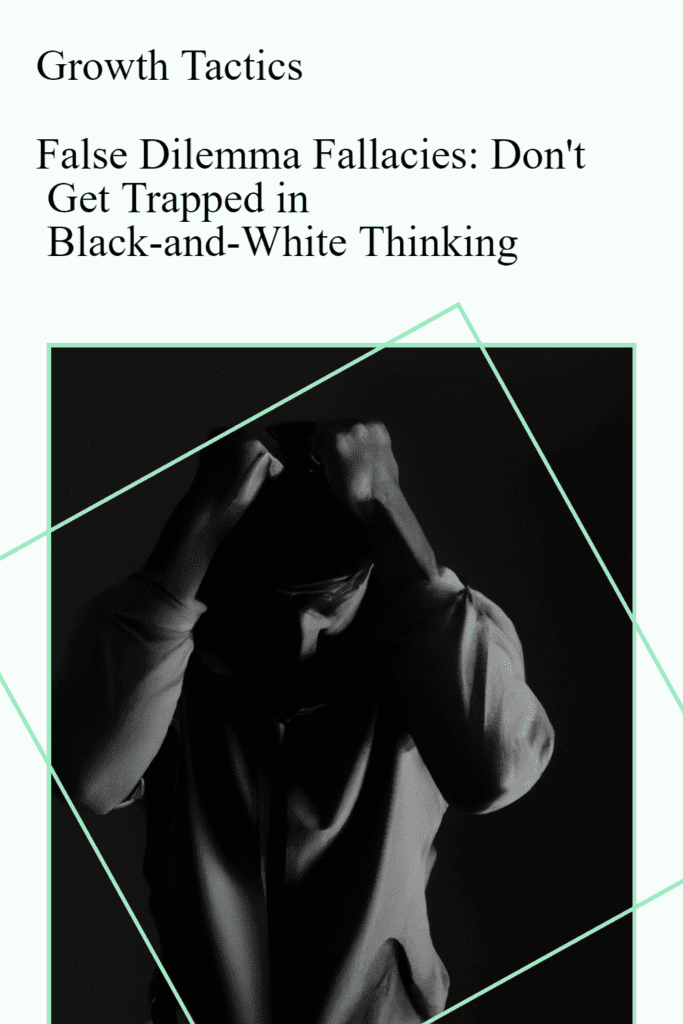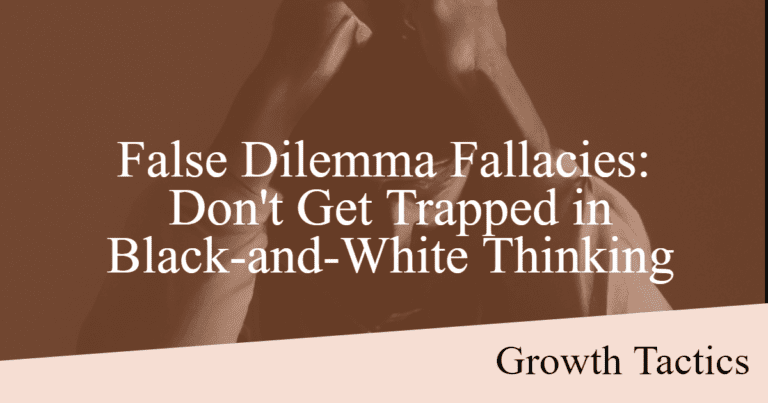Have you ever found yourself feeling trapped between two extreme options, even when you suspected there was a middle ground? You may have encountered a fallacious argument known as a false dilemma or a false dichotomy. In this article, we will explore the definition and examples of this logical fallacy and how to avoid the pitfalls of black-and-white thinking.
Jump To Section
What is a False Dilemma?
A false dilemma is a logical fallacy that presents only two options as mutually exclusive and exhaustive, ignoring the fact that many additional options or possibilities exist. This type of fallacy is also known as a false dichotomy, either/or fallacy, or black-and-white thinking.
The false dilemma occurs when a limited number of options are presented as definite, excluding other alternatives that may exist. Often the false dilemma is intentionally used to manipulate people into making decisions that benefit someone else.
For example, consider the argument that presents only two choices: “Either you’re with us, or you’re against us.” This polarizing statement ignores the fact that a middle ground or alternative options may exist. Another example is the statement, “You’re either part of the solution or part of the problem.” This statement implies that there are only two choices to solve a problem when there could be more than two.
Examples of False Dilemmas
False dilemmas occur in various contexts, including personal relationships, politics, and advertising. Here are some examples:
Personal Relationships
False dilemmas can exist not only in formal arguments but also in personal relationships, such as between couples or friends. Here are a few examples to help recognize how false dilemmas can show up in personal life:
- “If you loved me, you would agree with me.”
- “We can either break up or get married right now.”
- “If you don’t come to the party with me, I’ll break up with you.”
- “Either you support my career or you don’t love me.”
- “If you don’t agree with me, then you’re not my real friend.”
- “You either help me or sabotage me.”
Politics
In politics, false dilemmas are common during election campaigns when candidates use them to polarize voters. Some examples of false dilemmas within politics can include:
- “You’re either a patriot or a traitor.”
- “You’re either for us or against us.”
- “You’re either for gun control or you’re against it.”
- “We can either have a strong military or be vulnerable to attacks.”
- “Either we allow all refugees into the country, or we close our borders entirely.”
Advertising
Finally, advertisers can also use false dilemmas to manipulate people to buy their products. Here are some examples:
- “You’re either clean or dirty. Use our soap.”
- “You either drive a Prius or you hate the environment.”
- “You can either smell good or not, use our perfume.”
- “If you don’t use our sunscreen, you will get a skin cancer.”
- “You either look younger or you don’t, use our anti-aging cream.”
- “Drink our soda or be thirsty.”
The Distinction Between False and Legitimate Dichotomies
A legitimate dichotomy presents two mutually exclusive and exhaustive options, where only one of them must be true. For example, “You’re either alive or dead” is a legitimate dichotomy because no other options exist. When a legitimate dichotomy exists, the argument is valid.
However, a false dichotomy presents only two options, but additional options are excluded and may exist. This argument is fallacious. The dilemma fallacy is a logical fallacy that presents a false dichotomy.
Recognizing the distinction between false and legitimate dichotomies is essential for critical thinking. By understanding that there may be more options or shades of gray between two extremes, you can avoid falling into the trap of black-and-white thinking and make more nuanced and informed judgments.
Remember, not every situation can be neatly categorized into two options. By acknowledging the possibility of alternative perspectives or solutions, you can strive for a more comprehensive understanding and avoid the errors associated with false dichotomies.
How to Avoid the False Dilemma Fallacy
To avoid the false dilemma fallacy, you need to recognize when an argument presents only two options and ignores the fact that more possibilities or additional options may exist. Here are some tips to avoid the false dilemma fallacy:
1. Look for additional options.
When faced with a binary argument, take a step back and question whether there are additional options or possibilities that may have been overlooked. Resist the urge to accept the presented choices as the only ones available. By expanding your perspective, you can open up new avenues for exploration and uncover more nuanced solutions.
2. Consider the spectrum of options.
Often, a false dilemma presents a narrow viewpoint by focusing solely on extreme choices. Instead of thinking in black-and-white terms, consider the spectrum of options that exist between the two extremes. This allows you to consider a wider range of possibilities and find a middle ground that may offer a more balanced and pragmatic solution.
3. Ensure that the issue at hand is the only subject of discussion.
In the presence of a false dilemma, it is crucial to keep the discussion focused on the specific issue at hand. Be aware of attempts to introduce unrelated topics or distractions that can steer the conversation away from the core problem. By staying focused on the original argument, you can better identify any false dichotomy and maintain a productive dialogue.
4. Find the middle ground.
Instead of succumbing to the false dilemma of having to choose between two extreme options, actively seek out a middle ground that incorporates the best elements of both choices. Look for compromises or alternative solutions that address the concerns raised by both sides. By finding common ground, you can foster understanding and collaboration, leading to more effective problem-solving.
By employing these strategies, you can navigate through false dilemmas and avoid falling into the fallacy. Remember to question assumptions, consider alternative options, and stay focused on the relevant issues at hand. By doing so, you can make more informed decisions and engage in more fruitful discussions.
Bullet Points of What to Remember
- The false dilemma is a logical fallacy that presents only two options as mutually exclusive and exhaustive, ignoring the fact that many additional options or possibilities exist.
- The false dilemma is also known as a false dichotomy, either/or fallacy, or black-and-white thinking.
- Determine whether the argument is a true dichotomy or a false dichotomy by examining whether there are additional options.
- Look for the middle ground between the two extreme options to find a more logical solution.
By remembering these points, you can guard yourself against fallacies designed to present black-and-white options as the only possible choices. By recognizing alternative possibilities, you can steer clear of the false dilemma fallacy and make better decisions.
FAQ
What is a false dilemma fallacy?
A false dilemma fallacy, also known as a false dichotomy or black-and-white thinking, is a logical error that presents only two options as mutually exclusive and exhaustive, ignoring other possible alternatives.
How is a false dilemma different from a legitimate dichotomy?
A legitimate dichotomy presents two truly mutually exclusive and exhaustive options (e.g., “You’re either alive or dead”). A false dilemma, on the other hand, presents only two options when additional possibilities exist.
Can you give some examples of false dilemmas in everyday life?
Yes, some examples include:
- In relationships: “If you loved me, you would agree with me.”
- In politics: “You’re either a patriot or a traitor.”
- In advertising: “You’re either clean or dirty. Use our soap.”
How can I avoid falling for the false dilemma fallacy?
To avoid this fallacy:
- Look for additional options beyond the two presented.
- Consider the spectrum of possibilities between extremes.
- Stay focused on the specific issue at hand.
- Seek out middle ground or compromise solutions.
Why is it important to recognize false dilemmas?
Recognizing false dilemmas is crucial for critical thinking. It helps you make more nuanced and informed judgments, avoid manipulation, and find more comprehensive solutions to complex problems.
Are false dilemmas always intentional?
Not necessarily. While some false dilemmas are intentionally used to manipulate people, others may arise from genuine black-and-white thinking or oversimplification of complex issues.
How can I respond when someone presents a false dilemma?
When faced with a false dilemma, you can:
- Point out that there may be more than two options.
- Ask for evidence that only the presented options exist.
- Suggest alternative possibilities or middle-ground solutions.
- Encourage a more nuanced discussion of the issue.


